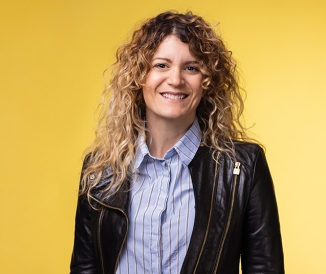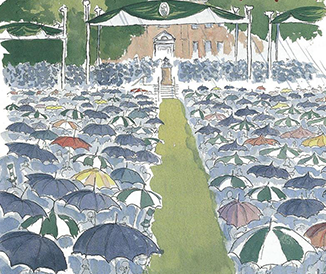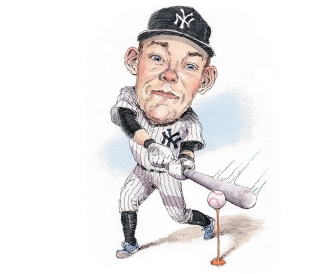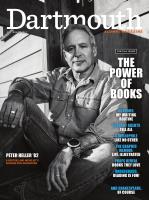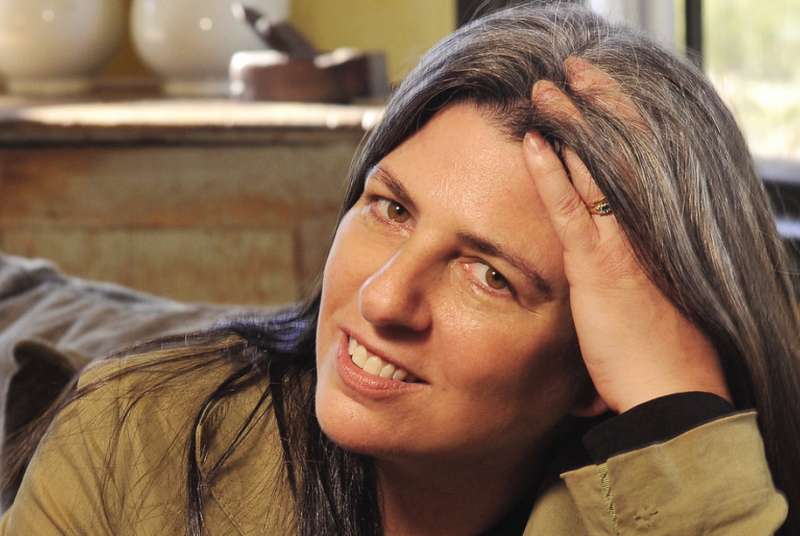
Art Imitates Life
The Devil and Webster is not the first book Korelitz has set on a campus. Admission, published in 2009 and later made into a movie starring Tina Fey, was set at Princeton, where her husband, poet Paul Muldoon, teaches and where she researched the book by being an outside reader for the admissions office. For this book, in which her college has a female president, Korelitz spent time with a couple of presidents. But research takes a writer only so far, the former DAM intern acknowledges. Korelitz told DAM in a 1983 interview about the creative writing class she took spring of her senior year: “The teacher pointed out that in fiction you can make things up. Angels sang.”
Your book will strike readers as prescient given that a key plot element is denial of tenure to a popular, minority professor—an issue that roiled the Dartmouth campus last spring, well after your book was written.
My husband has this theory that when you’re writing the right thing, the world just kind of bends to your will, and suddenly every time you open Dartmouth Alumni Magazine or The New York Times you see that reflected.
The day after I sent my first draft to my editor, I picked up The New York Times and there was my book on the front page. It was Yale [where faculty response to student outrage over a Halloween party was seen as insulting to minority students, who also decried a shortage of minority faculty] and the University of Missouri [where minority students claimed they were treated disrespectfully], but very much my story. At the University of Missouri there was even an incident in a basement where somebody had written in excrement [something that also takes place in The Devil and Webster].
Another issue explored in your book is the treatment of transgender students. Why did you decide to incorporate that?
I had been reading about that beforehand. One of the college presidents who let me kind of follow them around for a day was Debora Spar at Barnard. The day I spent in her office, that’s all they talked about. That is a huge issue, especially for the women’s colleges right now: how to deal with transgender students.
Webster, your fictional college, has much in common with Dartmouth. How did you decide which Dartmouth elements to include?
Well, I’m really fascinated by Dartmouth’s history and position in the political and educational landscape. If one idea that’s lurking around this novel is capitulation—whether it’s personal capitulation or political capitulation or any of the capitulations that we all practice as we go through our lives—Dartmouth had this moment, in the early 1970s, in which we could have gone one way, but we went another.
Can you elaborate on that?
There was a moment in the early 1970s, when women were admitted, minorities were beginning to turn up in greater numbers and Kemeny rededicated the College to educating Native Americans—its original purpose. When Native Americans turned up on campus, and they found their presence inconsistent with the presence of the Indian symbol, the symbol was eradicated. So a great deal of change in a short period of time, but taking all of the change to its ultimate destination would have meant getting rid of the fraternities. And that was the moment when alumni basically said, “This far, no farther.” And the College—well, agreed might be one way to put it. Capitulated would be another.
Williams College did take that step when it became clear that the fraternities were not consistent with an intellectual and academic environment. They made their fraternities into dormitories.
Basically, everything that Dartmouth has tried to do, from that moment in the 1970s—the proposed student life initiative and the housing clusters—has been a Band-Aid on the fact that we didn’t get rid of the fraternities. It’s the wound the College never opened up and let heal. Two generations later, we’re still trying to compensate for the Animal House image.
Is it too late to heal the wound?
I don’t know how it can be fixed. I’m sure there are many people out there who’d say, “There’s nothing to fix. Everything is great.” But I have a son applying to college right now and he wouldn’t apply to Dartmouth, even though I begged him to, because he said, “It’s a fraternity school and they all just get drunk.” Multiply that by all of the kids who aren’t applying and it’s a problem.
I say this with great love for the College and with gratitude for the education I got and the friends I made there. It’s still a world-class institution and it’s beautiful beyond compare. It’s full of brilliant people, amazing faculty. Is it everything it could be? No.
Is there any particular reaction you would like readers to have to The Devil and Webster?
As always, I hope people will find it an intellectually rigorous read. And I hope they’ll be surprised by the plot twists. If you’re like me, while you’re reading your brain is already saying, “Well, I’m wondering if this is going to happen, or if that’s going to happen.” If a writer can pull off a real surprise for a reader like that, you’re doing pretty well.
Is there anything you want to tell readers about the book without giving away the plot?
It’s not Dartmouth, it’s Webster. But I would hope that my affection for the College is part of Webster. My concerns about the College are also part of Webster. But it’s fiction.
Did any of your characters take off in a direction you didn’t anticipate?
That is the great adventure of writing fiction, of probably any creative venture. Most writers love their characters. I’m the only writer I know who sometimes talks about mine in a derogatory way. I don’t know what that says about me [laughs]. I once told someone I had never written a character I didn’t want to slap. They’re obtuse. They’re good people, but sometimes they don’t behave very well. It’s incredibly common for me to read reviews on Good Reads or Amazon or wherever, where people say, “Well, I just didn’t like her.” I always want to say, “Well, I’m not sure she would like you either, but what does that matter?” I adore Jane Austen, but I’m not looking for a best friend in Elizabeth Bennet.
Does this apply in Devil?
Yes. Naomi Roth, the Webster college president, is a good enough person, but she’s unlikeable. Maybe that’s why she has a problem with female friendships. In The Sabbathday River, an earlier book of mine in which she appeared, there’s a woman she thinks of as a friend who’s not really her friend at all. Something similar happened in The Devil and Webster. I wish she’d learned from her earlier experience, but how many of us really do?
Is it fair to say you have an interest in college admissions given your previous book and a key character in this one, who is Webster’s admissions director?
I guess so. Ask me again after my son is through the process. I feel that admissions is of great interest to many, many people: how it works and the concept of fairness and how malleable that is, depending on what seat you’re in. For me, it’s an ongoing interest not just for personal reasons but for socio-psychological reasons. I might have to give it a rest after this.
Will Dartmouth alums and others familiar with the College interpret your book differently than other readers?
They might. But people who went to Wesleyan may also feel like they recognize the college in the novel. The book was inspired by a story someone told me about a real event that occurred at Wesleyan in the 1990s. It got my attention because it had liars, politics and political correctness—all things I love to write about. In a way, Webster College is what Dartmouth would have become if we had finished up what we started to do in the 1970s. Would that have been a good thing? I don’t know. Wesleyan has a lot of issues, too.
What else, if anything, about Dartmouth influenced your plot?
A very early ingredient in this book was an article I cut out of the alumni magazine several years ago about the 1970s generation of Native Americans at Dartmouth [“Strangers in a Strange Land,” November/December 2013]. I thought it was fascinating, because that group of students was like the canary down the mine in a way. A lot of them didn’t make it through Dartmouth, and when they were interviewed they talked about dropping in and dropping out. Many of them went back to where they’d come from to finish college, and yet they didn’t seem angry. They were reflecting on an experience that most of us didn’t realize had been unfolding at Dartmouth. I filed that away because I already knew I wanted to return to it in a novel.
What in particular made their stories different from the many alums who say they didn’t fit in when they were at Dartmouth?
I remember a conversation I once had with an English professor during my years at Dartmouth. He said that students often felt like outsiders at the College not because there weren’t others like them but because the “social mainstream” was so omnipresent and so “opaque” that students who weren’t a part of that couldn’t see one another. You really had to look hard to find other kids who weren’t going to frats or on sports teams. Where were they? In my time they were in the Outing Club or working on the publications and a few other quirky places, but often they had moved off campus and you really had to make an effort to build and maintain those relationships. Still, most of my closest friends at Dartmouth were students I met at the very beginning, either because we were on freshman trips together or living in the same dormitories, and many of them did eventually join fraternities and sororities—unlike me—but we were able to maintain our friendships nonetheless. My closest Dartmouth friend is a woman I met senior spring for the first time. We still regret all the fun we didn’t get to have in college, but we have tried our best to make up for it in the 32 years since.
How has your experience shaped your reaction to real campus protests such as the ones recounted in your book?
Seeing the parallels between my story and what was happening the day after I submitted my manuscript was an extraordinary moment. And watching what was happening at Yale—a very, very liberal campus—in the wake of that 2015 Halloween party [when students protested a faculty member’s stance that administrators need not counsel students on culturally appropriate costumes]? That was one of the dumbest things I’ve ever seen: Students getting that worked up about Halloween costumes. I wrote a piece for The Huffington Post about the protest [huffingtonpost.com/author/jean-hanff-korelitz], which probably eight people read, and in it I talked a little bit about my time at Dartmouth.
Did your experience with students who founded The Review differ from the way many of today’s students are reacting to opposing opinions on their campuses?
One of the interesting things about my time at Dartmouth was that it coincided with the first years of The Dartmouth Review. I had never met people like those students. I did read The Review. I did want to know what they were saying. I considered that to be an important part of my educational experience, because I had gone to a very liberal high school and I’d grown up among people like myself. In my view, this is why you go to college, to meet people who are just as persuaded by viewpoints that are not your own. You can reject them; I certainly did, but first I listened.
I think [former Review editor] Dinesh D’Souza ’83 might be surprised to learn that I listened to him in college, but I did. I haven’t listened to him since, because I think he’s an idiot, but I was also an idiot in college. That’s the right time to be an idiot.
Do you already have plans for another book?
I just did a play [The Dead, 1904, called by The New Yorker an “immersive recreation of James Joyce’s story,” staged at New York City’s American Irish Historical Society] with my husband, so my head is full of theater projects. My sister, with whom I produced The Dead, 1904 as Dot Dot Productions, and I will revive The Dead, 1904 this fall in New York City, but we are also developing another project that involves ghost stories—another immersive project. The long-term plan is to develop a couple of kind of traditional Broadway-style musicals.
Has it been difficult to work with your husband—something some couples love and some struggle with?
We’ve had a pretty good experience, maybe because we never actually worked together [laughs]. I did the first draft. He did the second draft. Then I took that into rehearsal and made the adjustments that were needed. Sometimes I would say, “Look, here our director wants us to cut that line that you wrote. I’m cutting it.” We didn’t have knock-down, drag-out fights, nothing like that.
If The Devil and Webster is made into a movie would you want more creative control than you had when Admission became a movie?
It’s funny you should ask that, because when Admission happened, I didn’t even raise my hand to say, “Ooh, can I write the script?” And Karen Croner wrote the screenplay. But last week we got an offer from David E. Kelley for [Korelitz’s 2014 novel] You Should Have Known, which I’m thrilled about, but I’m not writing the script for that, either.


